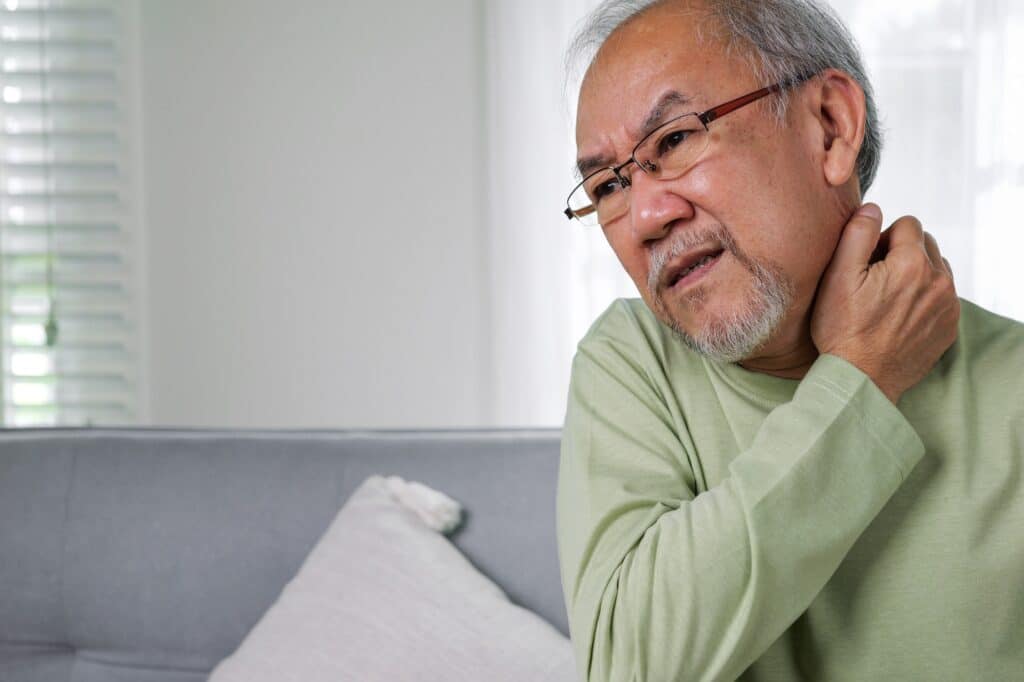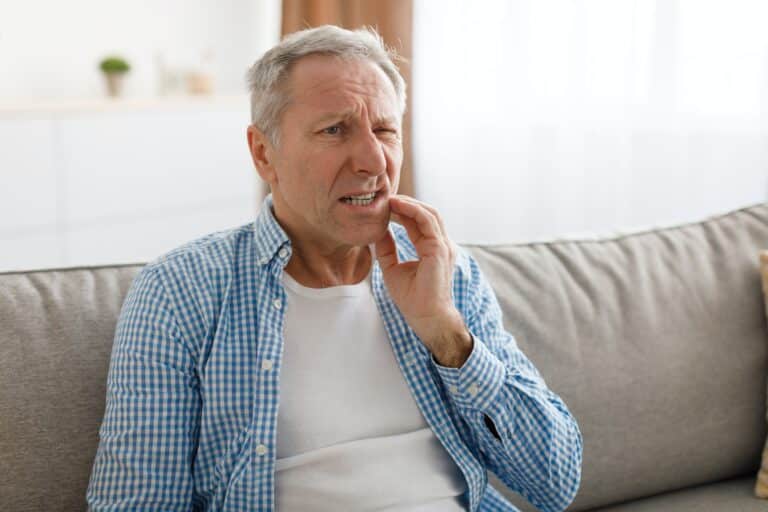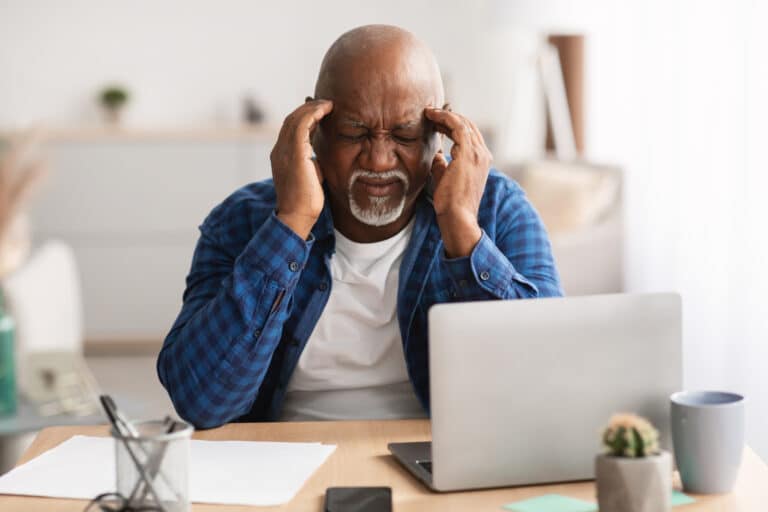Neck pain is something many of us will deal with, especially as we get older. It’s more than just a stiff neck now and then; it’s a real problem for about 30% of us each year.
In this article, we will closely examine the neck, learn why it can begin to hurt, and share some easy ways to keep it feeling good. We’ll cover the bones and muscles in the neck, what can go wrong as we age, and how to help prevent or ease the pain.
Whether you’re dealing with a new twinge or an old ache, you’ll find helpful tips to keep your neck in tip-top shape to enjoy life without that nagging neck pain.
Basic Anatomy of the Neck
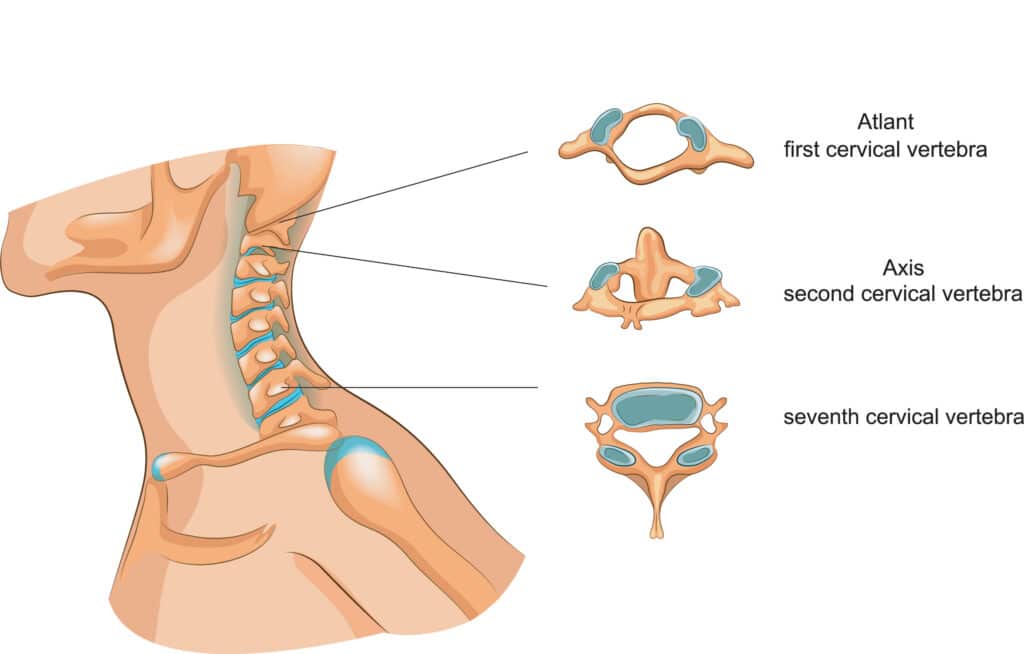
In my practice, I have found that a little bit of basic neck and spine anatomy can be beneficial in improving my patients’ understanding of their neck pain.
The cervical spine is the anatomical term for the neck region of the spinal column.
The neck consists of seven bony vertebrae connecting to the thoracic spine (the middle spine) at the lower part and the skull at the top. The seven vertebrae articulate and interact with each other in a few ways.
First, fluid-filled discs separate the spine’s vertebrae (individually known as a vertebra or vertebral body). They help to make the spine more flexible, allowing for shock absorption.
On the outer edges of the vertebrae are tiny, bony “wings” that join with the vertebrae above/below to form the facet joints. These joints help the neck to rotate and bend.
The Spinal Cord
The spinal cord starts as an extension of the brain and travels down the spinal canal length as part of the body’s nerve center.
Individual nerves branch off the spinal cord at each spine segment through a bony opening called the foramen between the vertebral body and the facet joint.
Nerves branching off in the neck region of the spine travel mainly into the arms to allow the brain to control your muscles but also allow sensation and movement in your upper extremities.
Neck Movement
The neck is meant to move relatively freely, but ranges vary from person to person.
A healthy neck can flex (look down) about 80 degrees, extend (look up) about 70 degrees, bend to the side between 30-45 degrees, and turn in each direction 80-90 degrees.2
As you age, it is common to see a reduction in this range of motion, which you might be familiar with as a chronically “stiff neck.”
Common Causes of Neck Pain
Neck pain can be categorized in several ways and may be treated differently based on your symptoms.
First, it is essential to distinguish between new neck pain due to recent trauma or injury versus chronic neck pain with a more gradual onset. More gradual pain is typically associated with bony changes or postural causes, while new and acute pain is often caused by trauma, like whiplash injury.
Another distinguishing factor of neck pain is the presence of symptoms that radiate into your arm, sometimes called radicular symptoms, due to compression around the nerve roots.
This type of pain is typically described as a shooting sensation. It can be associated with numbness or a burning feeling in the arm. This type of pain means a nerve is involved in the injury. This can occur as a pinched nerve or other nerve-related issues.
Neck pain is rarely a medical emergency. Urgent follow-up by a doctor is necessary if you are experiencing the following, especially after an injury:
- Neck pain after an accident, like a fall or car accident
- Loss of bowel or bladder control, nausea, vomiting, or dizziness
- Unexplained weight loss, fever, or chills
- New muscle weakness in the arms and hands, for example, suddenly dropping things.
- New neck stiffness restricting your ability to turn your head.3
Types of Neck Injuries & Disorders

Musculoskeletal Disorders or Injuries
Several structures, including the neck muscles, ligaments, bones, and nerves, can cause pain in your neck. New or sudden pain is commonly due to a muscular strain, such as lifting something too heavy.
Muscular pain is often due to weakness, strain, or overuse. In chronic conditions, this is commonly related to poor posture over long periods or repetitive movements leading to irritation in the neck.
My patients often tell me they can “poke” this pain, meaning they can physically touch the area that hurts and replicate their symptoms. This may feel like muscle tightness or soreness, usually on the outside of the neck and tops of the shoulders.
Bony pain is most commonly due to wear and tear over time and is generally more gradual. Symptoms typically include a loss of mobility and a sensation of stiffness.
Common conditions related to bony changes include osteoarthritis or central or foraminal stenosis. Stenosis refers to a narrowing of the space the nerves travel through.
To some extent, bony changes are normal as we age. When talking with my patients about bony changes, I compare them to wrinkles on the skin. As we age, the elasticity of the skin changes, resulting in wrinkles. A similar phenomenon happens in the bones.
Arthritis, Osteoporosis, Fractures & Disc Herniation
Normal wear on the joints makes them less smooth, causing stiffness. This becomes painful and problematic when it occurs in excess, often resulting in arthritis.
Fractures can occasionally occur in the cervical spine due to trauma. Fractures are especially common if you have a history of low bone density. This should be treated as an emergency.
Nerve pain can travel from the neck into the arm or shoulder blade. It may be caused by gradual degenerative changes, such as stenosis or disc degeneration, or it can be due to an acute injury, like disc herniation.
A disc herniation refers to the protrusion of the inner substance making up the disc which can then press on and irritate surrounding nerves.
Sometimes, your neck pain may be caused by a few different structures simultaneously. In the absence of injury, neck pain often becomes classified as “nonspecific,” meaning there is no one specific structure causing the problem.3
Keeping Your Neck Healthy
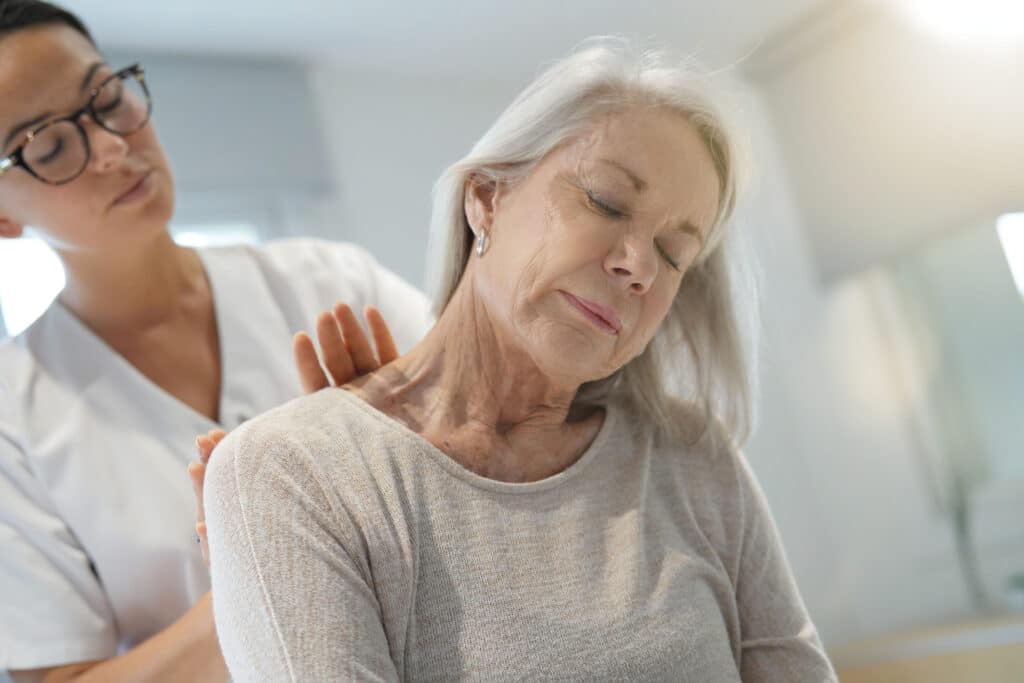
You can do several things to help keep your neck healthy, mobile, and strong throughout life.
Posture plays a significant role in your neck health, especially in the era of technology. Proper posture is critical, especially when sitting with screens for long periods.
Many of my older patients spend ample time sitting at a desk, looking at a computer. They commonly fall into a slouched posture with their head shifted forward to help see the computer screen.
Over time, this postural “distortion” pattern can cause tightness and pain in the back of the neck due to overuse of certain muscles or joint stiffness.
When sitting correctly, think about sitting up as tall as possible with your ears over your shoulders. Your shoulders should be relaxed, not shrugged up by your ears.
Generally, getting up and moving around at least once per hour is best to change your position and put your body in a new posture to reduce stiffness.
As you age, keeping your neck moving through its full range of motion is essential, as lack of use can also lead to stiffness. This can be accomplished through gentle stretches or exercises to keep your joints mobile.
Improving Your Neck Pain
Once you understand where your neck pain is coming from, it becomes easier to manage. With all new injuries or severe pain, it is always best to consult your doctor or physical therapist first to ensure no serious conditions, such as a fracture, have occurred.
Your doctor may order further testing, like an X-ray or MRI, to help identify what is causing your pain. These are not always necessary, and a proper examination in the office may be sufficient.
Surgery may be indicated in severe cases depending on the type of injury. However, conservative treatment, including exercise, physical therapy, or injections, may be recommended first, as surgery has several other serious risks.
Exercise and manual therapy are among the most effective ways to manage neck pain. Exercises for neck pain typically include a combination of stretching of the neck and strengthening of the upper back and shoulders.
A physical therapist may use various exercise-adjacent strategies to help with your neck pain, including but not limited to massage, joint mobilizations, and heat or ice.
Key Takeaways
- Neck pain is prevalent, affecting 30% of people annually, and is the fourth leading cause of disability.
- Understanding neck anatomy and movement can aid in managing neck pain.
- The neck, or cervical spine, has seven vertebrae with fluid-filled discs for flexibility and shock absorption.
- The neck’s range of motion varies by individual and decreases with age, leading to stiffness.
- Neck pain can result from acute trauma or gradual onset due to posture or age-related changes.
- Immediate medical attention is required if severe symptoms like loss of control, nausea, or new muscle weakness accompany neck pain.
- Neck pain can be due to muscle strain, wear and tear on bones, arthritis, fractures, or disc herniation.
- Posture is crucial for neck health, especially when using technology for long periods.
- Regular movement and exercises can maintain neck mobility and prevent stiffness.
- Treatment for neck pain may involve X-rays or MRIs, with surgery as a last resort; physical therapy and exercises are often effective.
FAQs
What are the common causes of neck pain as people age?
With aging, neck pain often results from the wear and tear of osteoarthritis, degenerative disc disease, or spinal stenosis. Poor posture and overuse can also lead to muscular strains. A healthcare provider might use imaging tests to diagnose the exact cause and recommend appropriate treatment.
How can lifestyle changes alleviate neck pain?
Lifestyle adjustments like improving posture, regular physical activity, and weight management can help reduce neck pain. Ergonomic modifications to work and living spaces, along with a supportive sleeping setup, also play a significant role in preventing and managing neck discomfort.
What non-medical treatments are recommended for neck pain?
Non-medical treatments such as physical therapy can be very beneficial for neck pain. Therapists may provide exercises and manual therapy techniques. Other treatments include yoga, tai chi, heat therapy, massage, and acupuncture, all of which can relieve pain and improve neck function.
When should someone seek professional help for neck pain?
Professional evaluation is advisable for severe neck pain, persistent discomfort despite self-care, or if accompanied by numbness, tingling, or weakness. Immediate attention is also necessary for neck pain resulting from an injury, like a fall, to rule out serious conditions.
Are there any particular stretches or exercises to avoid if I have neck pain?
Caution is vital with neck pain; avoid exercises that cause discomfort, high-impact activities, heavy lifting, or rapid neck movements. Gentle, low-impact activities are preferable, and it’s wise to consult a healthcare professional to ensure exercises are safe and appropriate.
Resources
- Cohen S. P. (2015). Epidemiology, diagnosis, and treatment of neck pain. Mayo Clinic proceedings, 90(2), 284–299. https://doi.org/10.1016/j.mayocp.2014.09.008
- Swartz, E. E., Floyd, R. T., & Cendoma, M. (2005). Cervical spine functional anatomy and the biomechanics of injury due to compressive loading. Journal of athletic training, 40(3), 155–161.
- Cologne, Germany: Institute for Quality and Efficiency in Health Care (IQWiG); 2006-. Neck pain: Overview. 2010 Aug 24 [Updated 2019 Feb 14]. Available from: https://www.ncbi.nlm.nih.gov/books/NBK338120/
- Hurwitz EL, Carragee EJ, van der Velde G, Carroll LJ, Nordin M, Guzman J, Peloso PM, Holm LW, Côté P, Hogg-Johnson S, Cassidy JD, Haldeman S. Treatment of Neck Pain: Noninvasive Interventions: Results of the Bone and Joint Decade 2000–2010 Task Force on Neck Pain and Its Associated Disorders. Eur Spine J. 2008 Apr;17(Suppl 1):123–52. doi: 10.1007/s00586-008-0631-z. Epub 2008 Mar 4. PMCID: PMC2271098.

